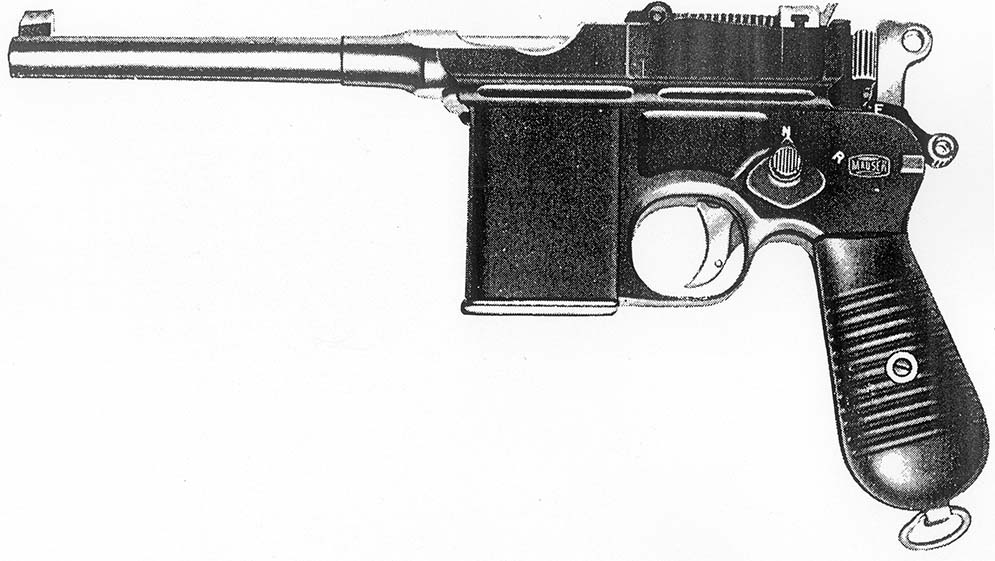By J.M. Ramos
Often referred to as “Pocket Machineguns”, the machinepistol is truly a unique piece of equipment among the many classes of fast firing weapons that have evolved through the years since the introduction of metallic cartridges. No one really knows who invented the very first machinepistol. Historical record shows that it was Beistigue Hermanos company of Spain that first introduced a machinepistol in the international market in 1927. Their entry is based on the very successful German Mauser Model 1896, most popularly known as the “Broomhandle”. While Mauser can be credited in perfecting a military class self-loading pistol strong enough to handle high-pressure loads and rapid-fire operation, it was the brothers Juan and Cosme Beistigui who took the design one step further. They developed a selective-fire weapon called “Royal” that became one of the most sought after battle pistols by Chinese warlords in the turbulent 1930’s.

Inspired by the success of the Royal particularly in the Far East, another Spanish firm Astra/Unceta entered the scene and developed their own version of a selective fire Broomhandle in 1927 called the model 900,901,902,903,904 and the last being the Model-F. The Model-F featured a cyclic rate reducer similar to that found on the Model-2 Royal machinepistol but is more refined and sophisticated.
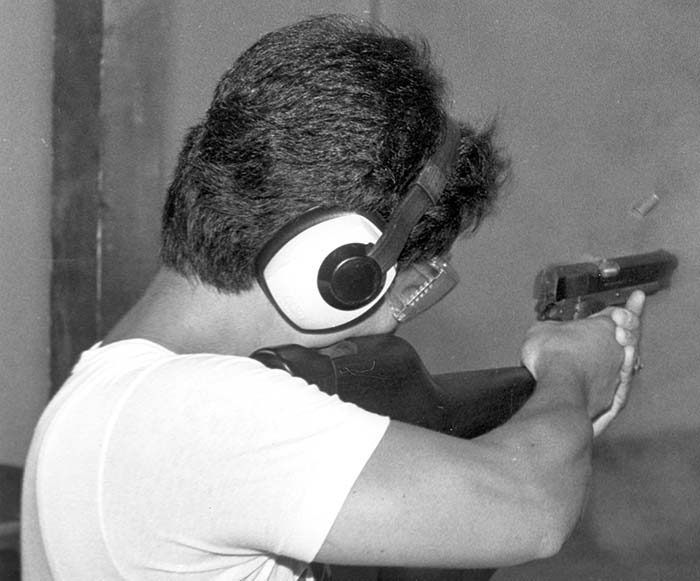
Finally, Mauser introduced their selective-fire model. Ironically, the German firm was forced into developing a selective-fire Broomhandle. Mauser had no plans to design and produce such a model in the 1930’s, but initiated a crash development program because of the successful introduction of the Spanish-made machinepistols on the Asiatic market. The first model of the Mauser Broomhandle machinepistol was designed by Joseph Nickl, an Austrian hired by Mauser to redesign the existing semi-auto pistol to provide selective-fire operation. The Nickl designed machinepistol was produced in limited quantities between l930 and 1931 with approximately 4000 made. The first designation used by Mauser for these pistols is “Reihenfeuer Model R-713” or Rapid Fire Mauser Pistol. An improved version of the R-713 was designed by Karl Westinger. This new model was designated “Mauser Schnellfeuer” or Model 712. The Schnellfeuers were sold mostly to the Chinese warlords in the l930’s but were also used in the submachinegun role in World War II by Hitler’s elite Waffen SS.
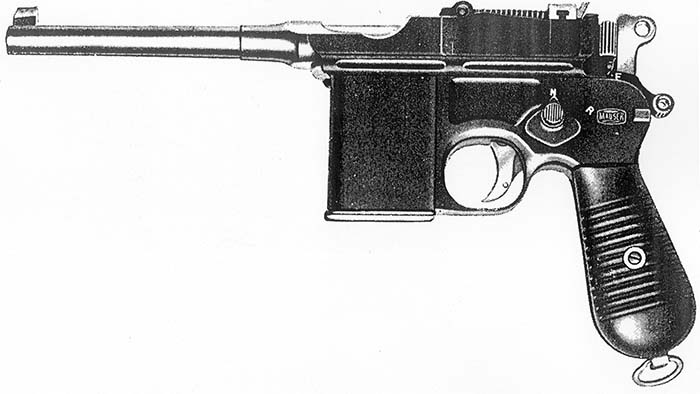
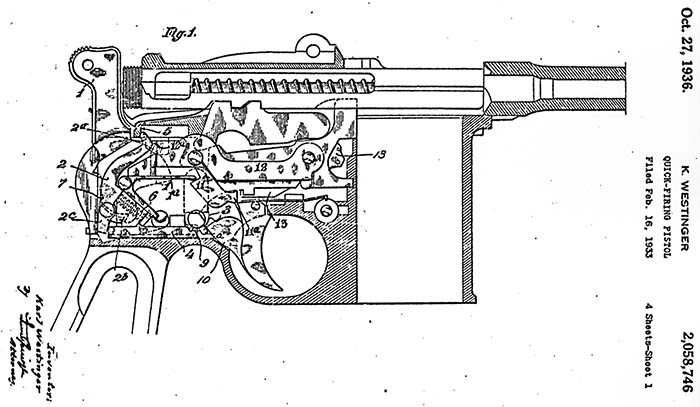
Then came John M. Browning’s .45 automatic pistol. When compared to the Mauser Broomhandle, the U.S. pistol is more modern, portable and more balanced for one hand shooting. Once the Colt forty-five auto became standard U.S. army issue in l911, other manufacturers soon explored its other possibilities beyond just an ordinary military sidearm. As if history repeated itself, it was once again a Spanish gunmaker that first saw these possibilities of a foreign design and made good use of it.
Like several leading Spanish arms manufacturers in the 1920’s and 1930’s, notably Star, Llama and Astra; it was the STAR factory located in the city of Eibar that actively pursued the development of a series of selective-fire machinepistols based on the 1911 pattern. In 1917, the factory introduced its first cal.45 auto pistol bearing the tradename “Izarra” instead of “STAR”. This model was offered to the French government who placed a large order. However, the order was not filled because of the end of the First World War in l918. The manufacture of this pistol was then abandoned and the pistol was never produced except for a few prototypes that were used in the French demonstrations.
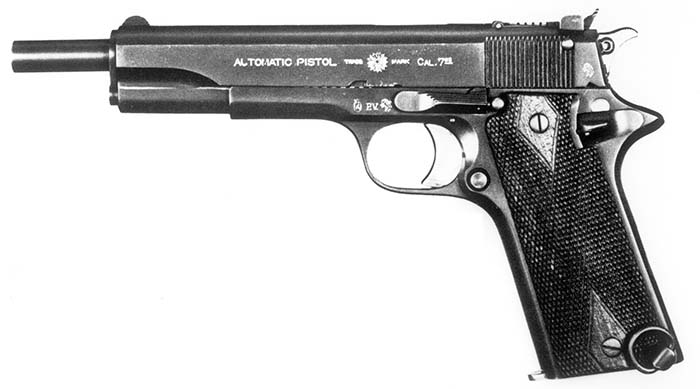
About the same year, Star decided to market a simplified version of the Colt 1911 pistol. The locking mechanism, external features and feed system were incorporated but not the trigger lockwork. Llama, on the other hand opted to copy the original 1911 in its overall format to include all its mechanical set up and external configuration. It’s a perfect 1911 clone but made with softer materials compared to Colt’s strong forged components.
While externally resembling the Colt automatic, the star pistol differs in trigger lockwork. Its trigger bar is externally mounted to the right side of the frame connected to a pivoting trigger. It has no separate disconnector like the Colt. Instead, the trigger bar has a raised hump and is depressed downward by the slide movement to disconnect itself from the sear after a shot is fired. The manual safety locks the hammer instead of the sear. To further simplify the Colt design, Star omitted the usual grip safety that blocks the trigger movement. Although the locking system, barrel arrangement and recoil spring assembly are completely identical to Colt’s, they are not interchangeable.

In 1930, the Star factory developed its first 1911 style machinepistol based on their full size semi-auto, the Model 1922. These pistols were chambered for the 9mm Para, 7,63mm (.30 cal. Mauser), .38 ACP, .45 ACP. The Spanish Guardia Civil selected the powerful 9mm Bergmann-Bayard cartridge for their service pistol.
All Star machinepistols incorporate a sliding-type fire selector mounted on a vertical dovetail at the right hand side rear of the slide where the grasping serrations were cut. When pushed upward, the weapon will fire semi-auto. On downward position, the gun will fire automatically as long as the trigger is held back or until the magazine is empty. The fire selector works in relation with the automatic tripping device mounted on the right side of the grip. The upper tip of the pivoting tripper is actuated by the protruding bottom end of the fire selector when set at full auto. The automatic tripping device will only make contact with the sear to trip the hammer mechanically at the very last stage of slide closure assuring that the slide and barrel are fully locked together before the hammer is tripped. The tripper assembly is neatly covered and secured into position by the grip panel. Star machinepistols are produced in different versions to include the standard models PD, AD and BD. Some models are equipped with detachable shoulder stocks, adjustable sights, long barrels and various hi-capacity magazines ranging from 15, 25 up to 32 rounds for 9mm and .38 ACP.

While the STAR machinepistols were considered very modern and sophisticated in their day, they deliver an excessive rate of fire of over 1000 rpm making it totally uncontrollable to shoot on full automatic. Accordingly, a very sophisticated rate of fire retarder was developed by the company to compensate this drawback and was incorporated on their last version; the “Modello Special” marketed in 1934. Unfortunately, despite all these marvellous features built into the Star machinepistols, they failed to attract wide market acceptance, although several countries in the Far East and Latin America have stirred limited commercial sales.

The first recorded full auto modification for the Colt .45 Automatic did not come from any manufacturer, rather; from an unknown gunshop in San Antonio, Texas operated by a young gunsmith named Himan S. Lebman. While lawmen and gangsters of the 1920’s admired the elegance and beastly beauty of the Tommy gun (Thompson SMG), Lebman also shared that same enthusiasm and dreamed of creating one himself. He began experimenting with converting sporting self-loading rifles and pistols to fire fully automatic as early as mid 1920’s, several years before the Spanish firm of Star started making their own.
During the 1928 revolution in Mexico, Lebman set up his gunsmith shop, supplying machineguns; rifles and even full auto converted weapons to Pancho Villa’s revolutionaries. This business venture was followed with his close association with the notorious John Dillinger gang, particularly with Lester Gillis, also known as Baby Face Nelson. Apparently, Lebman supplied at least two converted 1911 pistols to Baby Face and was working on a third – found by the F.B.I. still wired to a work bench in his shop when they arrested him in April 1934. Nelson had at least three full auto Colt .45’s, all of which are now in the F.B.I. collection. Two of the specimens, one of which was reported to have been the murder weapon of an F.B.I. agent, were seized when the notorious gang tried to shoot their way out of the Little Bohemia Motel in Wisconsin. The third Lebman-converted Government model was found when authorities raided Nelson’s hideout after the bloody encounter. This incident highly contributed to the enactment of the United States’ first Gun Control Act in 1934, requiring the registration of machinegun ownership to civilians.
Lebman’s experimentation in converting the 1911 to deliver full auto fire was quite extensive. All the various specimens taken from Nelson and from Lebman’s shop exhibit differences in mechanical arrangements as well as external features that included the addition of front grips and muzzle brake devices, something not explored by both Mauser and Star companies when they produced their machinepistols. Lebman was definitely one bright gunsmith who had envisioned what an ideal machinepistol should look like in order to be effective and controllable despite its excessive rate of fire and powerful .45 ACP cartridge.

The last conversion Lebman had developed prior to his arrest was perhaps the most reliable. This model featured a selective fire mechanism that was remarkably ingenious in both concept and mechanical arrangement. The F.B.I. loaned this pistol to the U.S. army in the mid 1930’s for extensive testing and evaluation at the Springfield Armory for its possible military application. Although ultimately Lebman’s machinepistol was not considered for military use, the army concluded that the converted weapon was by far the most reliable full-auto conversion of the 1911 service pistol. When the army returned the pistol to the F.B.I., the original fire selector button was lost; a regular screw replaced it. The conversion technique used by Lebman in this pistol became the basis for Colt’s later developments of the full auto 1911, which started in 1938 and lasted until 1949.

With Lebman’s converted pistol having caught the U.S. army’s attention in the mid 1930’s, it is quite possible that it became an inspiration to the Colt company who eventually undertook a program dedicated solely in the development of selective fire 1911 in various format incorporating many of the features found on the Lebman converted pistols. The threat of the Second World War is another reason that can be added to Colt’s sudden interest in exploring the possibilities of selective fire 1911 machinepistols and carbines for military applications. Colt’s research and development team for this project was headed by William L. Swartz and Horace J. Kennedy. Kennedy’s patent (2,462,505) filed July 28, l949 was a derivative of the Lebman design incorporating a split disconnector system. While many of Colt’s experimental select-fire 1911 weapons systems showed great potential, they failed to gain the interest of the military simply due to the fact that cheaper and more effective submachineguns like the Greasegun and Sten proved more desirable in actual combat conditions.

After WW II, millions of 1911 service pistols scattered throughout the world as carried by the GI’s in many war fronts. Browning’s .45 auto produced by Colt and other U.S. companies under contract during the war flooded the Asian theatre. One of the many principal recipients of the vast surplus guns are the Philippine army and constabulary scouts formed by the U.S. government after the country’s liberation by Gen. Douglas MacArthur in 1946. The author virtually grew up with the 1911, being the first training gun his father had taught him to shoot using a .22 conversion kit which started on his 6th birthday. My dad, an undercover operative for the Criminal Investigation Service (CIS) in the 1960’s owned and treasured a pair of Remington-Rand .45’s. These guns saved his life many times from the 7 attempts on his life. He retired with his trusted tools in the late 1980’s and today he still finds comfort and peace of mind at night knowing his beloved pair of big bores are still there when called upon.

Needless to say, my dad is my hero and inspiration in my growing up with guns. In the turbulent 60’s, 70’s and 80’s, he proved himself many times in the face of death and came out alive. Often, our home became a sanctuary to many people whose life was being threatened by corrupt politicians and hired goons. Today, he still lives a poor man and returned to farming, while many of his colleagues retired wealthy and powerful. He is truly an honest man who served his community beyond his call of duty. I could never be more proud of my dad for standing up for what he believes in.

While in the service, my dad has encountered and confiscated vast numbers of illegal weapons ranging from locally made imitation guns, to sophisticated converted automatic rifles, shotguns and pistols of both domestic and foreign make. Back in the late 60’s to the early 70’s prior to the declaration of Martial law in 1972 by President Marcos, political bodyguards often carried compact submachineguns, namely the UZI, Ingrams, pistolized Thompsons and chopped up M2 .30 carbines. On several occasions, in my high school days, I noted several converted army-issue 1911’s being carried by high-ranking officers operating in the rebel infested areas of central Luzon. Both the Ilocos province (Marcos’ hometown) and Danao of Cebu in the Visayas island are noted for their underground workshops producing all sorts of imitation guns as well as full auto conversion specialists with anything that shoots semi-automatically.

Prior to my entry in college circa l967, my dad brought home a converted 1911 confiscated from a hired political killer. The weapon was a Colt Government model in almost new condition. It was highly polished to appear like a stainless steel gun. The gun is very sharp looking and very well maintained. The weapon had a sliding type fire selector mounted at the rear right hand side of the slide that can be pushed up and down for the type of fire desired. The selector lever is attached to the firing pin stop that acted as the tripping shoulder for a separate auto sear. The hole for the firing pin stop is elongated to allow movement as controlled by the sliding fire-selector lever. The top of the extractor to the rear was modified to clear the connecting pin between the selector and firing-pin stop. The disconnector and sear appears unmodified. Visible was a full groove cut on the feed rail of the slide that allows the disconnector to maintain its upward position and not disconnect when the selector lever is on its upward position firing full auto. On its downward semi-auto position, the selector will cam the firing-pin stop with its added front stem extension riding over the disconnector, filling up a fraction of the groove at the rear. As the slide moves to the rear, the stem pushes down the disconnector to allow the hammer to engage the auto sear seated on the left side of the regular sear. As the slide homes into battery, a small step cut on the right side of the slide beside the firing-pin stop cams the top end of the auto sear releasing the hammer. The hammer will be automatically engaged by the regular sear holding it in fully cocked position until the trigger is pulled. In addition to its excellent workmanship which led me to believe that it was done in the more modern facility of Danao, the full auto pistol also came equipped with a well designed folding front grip and a muzzle brake. The conversion technique appears very sound and clean when compared to others that I have seen until the military government take-over in 1972.
Seventy years had passed since Lebman introduced his 1911 machineguns in history but yet John M. Browning’s masterpiece combat handgun still yearns to be totally explored in its ultimate form. Now that its high capacity format has been perfected in the form of the Para-ordnance, STI,SVI, Kimber, etc, the time is ripe to take a final look at its military and police potentials. This is the most dressed service pistol in existence today with vast arrays of enhancement devices readily available to include recoil reducing compensators, match grade barrels and hi-performance trigger groups. With these superb gadgetries completing the package, a new generation of 1911 machinepistols can now be put together utilizing the latest hi-capacity frame models. Add to that set-up a competition proven compensator device and a folding front grip and the end result could very well be the ultimate 1911 machinepistol for the 21st century that even John Browning himself would come to admire.
For machinegun collectors, the 1911 machinepistol is as rare as it can be. 1911 machinepistols and carbine prototypes like those ones made by Colt during WW II can fetch easily between ten to fifteen thousand dollars today. On rare occasion, a registered converted 1911 machinepistol will be offered for sale at a very high price equal to that of a Heckler & Koch MP5 submachinegun depending on the quality of workmanship and condition of the gun. Unfortunately, despite the popularity of the new generation hi-capacity 1911 today and the F.B.I. adopting it in numerous guises, still no manufacturer has gone one step further when other makers such as Glock, Beretta and CZ have all made selective-fire versions of their service class handguns. Perhaps some other time, John.
NOTE:
Part two of this series will cover the H&K VP-70 Beretta 93R, CZ-75 and Glock M-18 machinepistols (Design perspective of 21st century Machinepistols – beyond 1911.)
| This article first appeared in Small Arms Review V4N11 (August 2001) |



